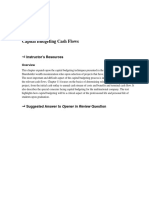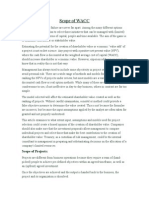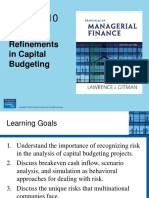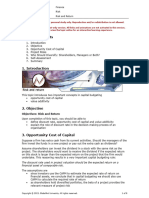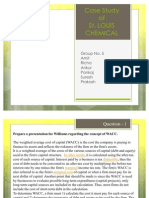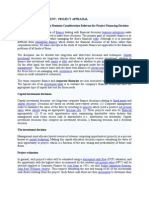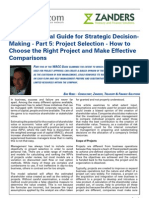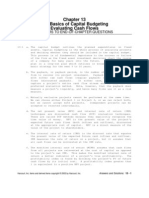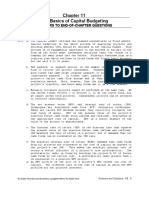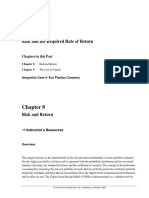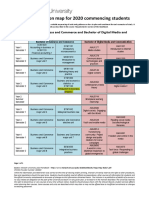Chapter 12
Chapter 12
Uploaded by
LBL_LowkeeCopyright:
Available Formats
Chapter 12
Chapter 12
Uploaded by
LBL_LowkeeCopyright
Available Formats
Share this document
Did you find this document useful?
Is this content inappropriate?
Copyright:
Available Formats
Chapter 12
Chapter 12
Uploaded by
LBL_LowkeeCopyright:
Available Formats
Chapter12
RiskandRefinementsinCapitalBudgeting
Instructors Resources
Overview
Chapters10and11developedthemajordecisionmakingaspectsofcapitalbudgeting.Cashflowsand
budgetingmodelshavebeenintegratedanddiscussedinprovidingtheprinciplesofcapitalbudgeting.
However,therearemorecomplexissuesbeyondthosepresented.Chapter12expandscapitalbudgeting
toconsiderriskwithsuchmethodsasscenarioanalysisandsimulation.Capitalbudgetingtechniques
usedtoevaluateinternationalprojects,aswellasthespecialrisksmultinationalcompaniesface,arealso
presented.Additionally,twobasicriskadjustmenttechniquesareexamined:certaintyequivalentsand
riskadjusteddiscountrates.Thechapterpresentsstudentswithseveralexamplesoftheapplicationofrisk
basedrefinementswhencapitalbudgetingintheirprofessionalandpersonallife.
Suggested Answer to Opener in Review Question
ThechapteropenerandtheFocusonEthicsboxinthischapterdescribedsomeoftheconsequences
oftheaccidentatBPsDeepwaterHorizonoilrig.ItisplausiblethatengineersandanalystsatBP
couldhaveimaginedaworstcasescenarioinwhichamajorspilloccurredatoneofthefirms
offshorerigs.HowmightathoroughscenarioanalysishaveinfluencedBPsoffshoredrilling
activities?
AnincreaseinthecostofcapitalmeansthatthemarketisdiscountingBPscashflowsatahigherrate.
ThatincludescashflowsfromBPsexistinginvestmentsaswellasinvestmentsthatthemarkethad
anticipatedthatBPwouldmakeinthefuture(andhencehadalreadybeenincorporated,atleastpartially,
intoBPsstockprice).Wehaveseenthatanincreaseinthediscountrateleadstoadeclineinthepresent
valueofacashflowstream,soitislogicalthatajumpinBPscostsofcapitalwouldbeassociatedwitha
majordropinthefirmsoverallvalue.
IfBPanalystshadimaginedthecostsofamajoroilspillasaworstcasescenario,itseemslikelythatBP
wouldhavetakenwhateverstepswerenecessarytopreventsuchanaccident.Thecashinflowsgenerated
byanoffshoreplatformareswampedbythecostsofamajorspill.Notallaccidentsarepreventable,of
course,butthefactthatBPengineerscouldnotquicklystoptheflowofoilintotheGulfofMexico
suggeststhatanaccidentofthetypethatoccurredontheoilrighadnotbeenplannedforinadvance.
2012PearsonEducation,Inc.PublishingasPrenticeHall
Chapter12RiskandRefinementsinCapitalBudgeting250
Answers to Review Questions
1. There is usually a significant degree of uncertainty associated with capital budgeting projects. There is the usual
business risk along with the fact that future cash flows are an estimate and do not represent exact values. The
uncertainly of each project cash flow stream will be different and thus each project has its own unique risk. This
uncertainty exists for both independent and mutually exclusive projects. The risk associated with any single
project has the capability to change the entire risk of the firm. The firms assets are like a portfolio of assets. If
an accepted capital budgeting project has a risk different from the average risk of the assets in the firm, it will
cause a shift in the overall risk of the firm.
2012PearsonEducation,Inc.PublishingasPrenticeHall
Chapter12RiskandRefinementsinCapitalBudgeting251
2. Risk, in terms of cash inflows from a project, is the variability of expected cash flows, hence the expected
returns, of the given project. The breakeven cash inflow the level of cash inflow necessary in order for the
project to be acceptable may be compared with the probability of that inflow occurring. When comparing two
projects with the same breakeven cash inflows, the project with the higher probability of occurrence is less
risky.
3. a.
Scenario analysis uses a number of possible inputs (cash inflows) to assess their impact on
the firms net present value (NPV) return. Scenario analysis can be used to evaluate the impact on return of
simultaneous changes in a number of variables, such as cash inflows, cash outflows, and the cost of capital,
resulting from differing assumptions relative to economic and competitive conditions. In capital budgeting,
the NPVs are frequently estimated for the pessimistic, most likely, and optimistic cash flow estimates. By
subtracting the pessimistic outcome NPV from
the optimistic outcome NPV, a range of NPVs can be determined.
b. Simulationisastatisticallybasedapproachusingrandomnumberstosimulatevariouscashflows
associatedwiththeproject,calculatingtheNPVorinternalrateofreturn(IRR)onthebasisof
thesecashflows,andthendevelopingaprobabilitydistributionofeachprojectsrateofreturns
basedonNPVorIRRcriterion.
4. a.
Multinational companies (MNCs) must consider the effect of exchange rate risk, the risk that the exchange
rate between the dollar and the currency in which the projects cash flows are denominated will reduce the
projects future cash flows. If the value of the dollar depreciates relative to that currency, the dollar value of
the projects cash flows will increase as a result. Firms can use hedging to protect themselves against this
risk in the short term; for the long term, financing the project using local currency can minimize this risk.
b. Politicalrisk,theriskthataforeigngovernmentsactionswilladverselyaffecttheproject,makes
internationalprojectsparticularlyrisky,becauseitcannotbepredictedinadvance.Totakethis
riskintoaccount,managersshouldeitheradjustexpectedcashflowsoruseriskadjusteddiscount
rateswhenperformingthecapitalbudgetinganalysis.Adjustmentofcashflowsisthepreferred
method.
c.
Taxlawsdifferfromcountrytocountry.Becauseonlyaftertaxcashflowsarerelevantforcapital
budgetingdecisions,managersmustaccountforalltaxespaidtoforeigngovernmentsandconsider
theeffectofanyforeigntaxpaymentsonthefirmsU.S.taxliability.
d. Transferpricingreferstothepriceschargedbyacorporationssubsidiariesforgoodsandservices
tradedbetweenthem;thepricesarenotsetbytheopenmarket.Intermsofcapitalbudgeting
decisions,managersshouldbesurethattransferpricesaccuratelyreflectactualcostsand
incrementalcashflows.
e.
MNCscannotevaluateinternationalcapitalprojectsfromonlyafinancialperspective.The
strategicviewpointoftenisthedeterminingfactorindecidingwhetherornottoundertakea
project.Infact,aprojectthatislessacceptablethananotheronapurelyfinancialbasismay
bechosenforstrategicreasons.SomereasonsforMNCforeigninvestmentincludecontinued
marketaccess,theabilitytocompetewithlocalcompanies,politicaland/orsocialreasons
(forexample,gainingfavorabletaxtreatmentinexchangeforcreatingnewjobsinacountry),
andachievementofaparticularcorporateobjectivesuchasobtainingareliablesourceofraw
materials.
5. Risk-adjusted discount rates (RADRs) reflect the return that must be earned on a given project in order to
adequately compensate the firms owners. The relationship between RADRs and the capital asset pricing model
2012PearsonEducation,Inc.PublishingasPrenticeHall
252Gitman/ZutterPrinciplesofManagerialFinance,Thirteenth Edition
(CAPM) is a purely theoretical concept. The expression used to value the expected rate of return of a security ki
(ki RF [b (km RF)]) is rewritten substituting an asset for a security. Because real corporate assets are not
traded in efficient markets and estimation of a market return, km, for a portfolio of such assets would be
difficult, the CAPM is not used for real assets.
6. A firm whose stock is actively traded in security markets generally does not increase in value through
diversification. Investors themselves can more efficiently diversify their portfolio by holding a variety of stocks.
Since a firm is not rewarded for diversification, the risk of a capital budgeting project should be considered
independently rather than in terms of their impact on the total portfolio of assets. In practice, management
usually follows this approach and evaluates projects based on their total risk.
7. RADRs are most often used in practice for two reasons: (1) financial decision makers prefer using rate of
return-based criteria, and (2) they are easy to estimate and apply. In practice, risk is subjectively categorized
into classes, each having a RADR assigned to it. Each project is then subjectively placed in the appropriate risk
class.
8. A comparison of NPVs of unequal-lived mutually exclusive projects is inappropriate because it may lead to an
incorrect choice of projects. The annualized net present value (ANPV) converts the NPV
of unequal-lived projects into an annual amount that can be used to select the best project.
9. Real options are opportunities embedded in real assets that are part of the capital budgeting process. Managers
have the option of implementing some of these opportunities to alter the cash flow and risk of a given project.
Examples of real options include:
Abandonmentthe option to abandon or terminate a project prior to the end of its planned life.
Flexibilitythe ability to adopt a project that permits flexibility in the firms production process, such as being
able to reconfigure a machine to accept various types of inputs.
Growththe option to develop follow-on projects, expand markets, expand or retool plants, and so on, that
would not be possible without implementation of the project that is being evaluated.
Timingthe ability to determine the exact timing of when various action of the project will be undertaken.
10.
Strategic NPV incorporates the value of the real options associated with the project while traditional NPV
includes only the identifiable relevant cash flows. Using strategic NPV could alter the final accept/reject
decision. It is likely to lead to more accept decisions since the value of the options is added to the traditional
NPV, as shown in the following equation.
NPVstrategicNPVtraditionalValueofrealoptions
11.
Capital rationing is a situation where a firm has only a limited amount of funds available for capital
investments. In most cases, implementation of the acceptable projects would require more capital than is
available. Capital rationing is common for a firm, since unfortunately most firms do not have sufficient capital
available to invest in all acceptable projects. In theory, capital rationing should not exist because firms should
accept all projects with positive NPVs or IRRs greater than the cost of capital. However, most firms operate
with finite capital expenditure budgets and must select the best from all acceptable projects, taking into account
the amount of new financing required to fund these projects.
12. The IRR approach and the NPV approach to capital rationing both involve ranking projects on the basis of
IRRs. Using the IRR approach, a cut-off rate and a budget constraint are imposed. The NPV first ranks projects
by IRR and then takes into account the present value of the benefits from each project in order to determine the
combination with the highest overall net present value. The benefit of the NPV approach is that it guarantees a
2012PearsonEducation,Inc.PublishingasPrenticeHall
Chapter12RiskandRefinementsinCapitalBudgeting253
maximum dollar return to the firm, whereas the IRR approach does not.
2012PearsonEducation,Inc.PublishingasPrenticeHall
254Gitman/ZutterPrinciplesofManagerialFinance,Thirteenth Edition
Suggested Answer to Focus on Practice Box: The Monte Carlo
Method: The Forecast Is for Less Uncertainty
AMonteCarlosimulationprogramrequirestheusertofirstbuildanExcelspreadsheetmodelthat
capturestheinputvariablesfortheproposedproject.Whatissuesandwhatbenefitscantheuser
derivefromthisprocess?
AgoodMonteCarlosimulationrequiresreasonablyaccurateestimatesofdata,includingprojectedsales
figures,productioncosts,associatedoverhead,marketingcosts,andothercostsrelatedtotheproject.
Gatheringthistypeofdatafornumerousprojectscanbeexpensiveintermsofemployeehours.However,
anysoundevaluationofaprojectwilleventuallyrequiresuchinformationgatheringbeforeadecisioncan
bemade.ThebenefitoftheMonteCarloprogramisthatitcanquicklyprovidearangeofprobableoutcomes
asthepotentialinputsarevaried.Forexample,ifthemarketingvariableisincreased,theeffectonpossible
salesoutcomecanbequicklydemonstrated.
Butevenbeyondthequickanalysisoftheeffectofchangingaprojectvariableisthattheneedforaccurate
andreasonableestimateswillforceprojectdeveloperstospendsometimeandefforttodeveloptheproper
dataforinputintotheMonteCarloprogram.Workingdiligentlytofindreliablecostestimatesandmarketing
estimatescanonlyenhancetheviabilityofaproposedprojectifitmeetsthecompanysselectioncriteria.
Suggested Answer to Focus on Ethics Box:
Ethics and the Cost of Capital
Istheultimategoalofthefirm,tomaximizethewealthoftheownersforwhomthefirmisbeing
operated,ethical?
Itisnotthegoalthatmakesmaximizationofshareholderwealthethicalorunethical,itisactionsofthe
financialmanagerinpursuitofthisgoalthatdictatesthelevelofethics.
Whymightethicalcompaniesbenefitfromalowercostofcapitalthanlessethicalcompanies?
Ifethicalbehaviorreducestheriskofinvestinginacompany(e.g.,reducesthevolatilityofthefirmscash
flows),ethicalcompaniesshouldbenefitmorefromalowercostofcapitalthanlessethicalcompanies.
Answers to Warm-Up Exercises
E12-1.
Sensitivity analysis
Answer: Usingthe12%costofcapitaltodiscountallofthecashflowsforeachscenariotoyieldthe
followingNPVs,resultinginaNPVrangeof$19,109.78:
Pessimistic
MostLikely
Optimistic
$3,283.48
$6,516.99
$15,826.30
2012PearsonEducation,Inc.PublishingasPrenticeHall
Chapter12RiskandRefinementsinCapitalBudgeting255
E12-2.
Using IRR as selection criteria
Answer: Theminimumamountofannualcashinflowneededtoearn8%is$11,270.54
N5,I8%,PV$45,000
SolveforPMT$11,270.54
TheIRRoftheprojectis12.05%.
N5,PV$45,000,PMT$12,500
SolveforI$12.05%
TheprojectisacceptablesinceitsIRRexceedsthefirms8%costofcapital.Sincetherequired
cashflowismuchlessthantheanticipatedcashflow,onewouldexpecttheIRRtoexceedthe
requiredrateofreturn.
E12-3.
Risk-adjusted discount rates
Answer: ProjectSourdoughRADR7.0%
N7,I7%,PMT$5,500
SolveforPV$29,641.09
NPVPVnInitialinvestment
NPV$29,641.09$12,500
NPV$17,141.09
ProjectGreekSaladRADR8.0%
N7,I8%,PMT$4,000
SolveforPV$20,825.48
NPVPVnInitialinvestment
NPV$20,825.48$7,500
NPV$13,325.48
YeastimeshouldselectProjectSourdough.
E12-4.
ANPV
Answer: YoumayuseafinancialcalculatortodeterminetheIRRofeachproject.Choosetheproject
withthehigherIRR.
ProjectM
Step1:
FindtheNPVoftheproject
NPVMKeystrokes
CF0$35,000,CF1$12,000,CF2$25,000,CF3$30,000
SetI8%
SolveforNPV$21,359.55
Step2:
FindtheANPV
2012PearsonEducation,Inc.PublishingasPrenticeHall
256Gitman/ZutterPrinciplesofManagerialFinance,Thirteenth Edition
N3,I8,PV$21,359.55
SolveforPMT$8,288.22
2012PearsonEducation,Inc.PublishingasPrenticeHall
Chapter12RiskandRefinementsinCapitalBudgeting257
ProjectN
Step1:
FindtheNPVoftheproject
NPVMKeystrokes
CF0$55,000,CF1$18,000,CF2$15,000,CF3$25,000
CF4$10,000,CF5$8,000,CF6$5,000,CF7$5,000
SetI8%
SolveforNPV$13,235.82
Step2:
FindtheANPV
N7,I8,PV$13,235.82
SolveforPMT$2,542.24
BasedonANPV,youshouldadviseOutcast,Inc.tochooseProjectM.
E12-5.
NPV profiles
Answer: Theinvestmentopportunityschedule(IOS)inthisproblemdoesnotallowustodeterminethe
maximumNPVallowedbythebudgetconstraint.InordertodeterminewhethertheIOS
maximizestheNPVforLongchampsElectric,wewillneedtoknowtheNPVforeachofthe
sixprojects.However,itdoesappearlikelythatLongchampsElectricwillmaximizefirmvalue
byselectingProject4(IRR11%),Project2(IRR10%),andProject5(IRR9%).Thetotal
investmentinthesethreeprojectswillbe$135,000,leaving$15,000excesscashforfuture
investmentopportunities.
Solutions to Problems
P121. Recognizingrisk
LG1;Basic
a.andb.
Project
Risk
Reason
Low
Thecashflowsfromtheprojectcanbeeasilydeterminedsince
thisexpenditureconsistsstrictlyofoutflows.Theamountisalso
relativelysmall.
Medium
ThecompetitivenatureoftheindustrymakesitsothatCaradine
willneedtomakethisexpendituretoremaincompetitive.Therisk
isonlymoderatesincethefirmalreadyhasclientsinplacetouse
thenewtechnology.
Medium
Sincethefirmisonlypreparingaproposal,theircommitmentat
thistimeislow.However,the$450,000isalargesumofmoney
forthecompanyanditwillimmediatelybecomeasunkcost.
2012PearsonEducation,Inc.PublishingasPrenticeHall
258Gitman/ZutterPrinciplesofManagerialFinance,Thirteenth Edition
High
AlthoughthispurchaseisintheindustryinwhichCaradine
normallyoperates,theyareencounteringalargeamountofrisk.
Thelargeexpenditure,thecompetitivenessoftheindustry,andthe
politicalandexchangeriskofoperatinginaforeigncountryaddto
theuncertainty.
Note:Otheranswersarepossibledependingontheassumptionsastudentmaymake.Thereistoo
littleinformationgivenaboutthefirmandindustrytoestablishadefinitiveriskanalysis.
2012PearsonEducation,Inc.PublishingasPrenticeHall
Chapter12RiskandRefinementsinCapitalBudgeting259
P122. Breakevencashflows
LG2;Intermediate
a.
N12,I14%,PV$35,000
SolveforPMT$6,183.43
b. N12,I10%,PV$35,000
SolveforPMT$5,136.72
Therequiredcashflowperyearwoulddecreaseby$1,047.27.
P123. Breakevencashinflowsandrisk
LG2;Intermediate
a.
ProjectX
ProjectY
N5,I15%,PMT$10,000
N5,I15%,PMT$15,000
SolveforPV33,521.55
SolveforPV$50,282.33
NPV PVinitialinvestment
NPV PVinitialinvestment
NPV $33,521.55$30,000
NPV $50,282.33$40,000
NPV $3,521.55
NPV $10,282.33
b. ProjectX
c.
ProjectY
N5,I15%,PV$30,000
N5,I15%,PV$40,000
SolveforPMT$8,949.47
SolveforPMT$11,932.62
ProjectX
ProjectY
Probability60%
Probability25%
d. ProjectYismoreriskyandhasahigherpotentialNPV.ProjectXhaslessriskandlessreturn
whileProjectYhasmoreriskandmorereturn,thustheriskreturntradeoff.
e.
ChooseProjectXtominimizelosses;toachievehigherNPV,chooseProjectY.
P124. Basicscenarioanalysis
LG2;Intermediate
a.
RangeA$1,800$200$1,600 RangeB$1,100$900$200
b.
NPVs
Outcome
ProjectA
ProjectB
Pessimistic
$6,297.29
$337.79
Mostlikely
513.56
513.56
7,324.41
1,364.92
Optimistic
2012PearsonEducation,Inc.PublishingasPrenticeHall
260Gitman/ZutterPrinciplesofManagerialFinance,Thirteenth Edition
Range
c.
$13,621.70
$1,702.71
AlthoughthemostlikelyoutcomeisidenticalforProjectAandB,theNPVrangevaries
considerably.
d. Projectselectionwoulddependupontheriskdispositionofthemanagement.(Aismorerisky
thanBbutalsohasthepossibilityofagreaterreturn.)
2012PearsonEducation,Inc.PublishingasPrenticeHall
Chapter12RiskandRefinementsinCapitalBudgeting261
P125. Scenarioanalysis
LG2;Intermediate
a.
RangeP$1,000$500$500
RangeQ$1,200$400$800
b.
NPVs
c.
Outcome
ProjectP
ProjectQ
Pessimistic
$72.28
$542.17
Mostlikely
1,608.43
1,608.43
Optimistic
3,144.57
4,373.48
RangeP$3,144.57$72.28$3,072.29
RangeQ$4,373.48($542.17)$4,915.65
Eachcomputerhasthesamemostlikelyresult.ComputerQhasbothagreaterpotentialloss
andagreaterpotentialreturn.Therefore,thedecisionwilldependontheriskdispositionof
management.
P126. PersonalFinance:Impactofinflationoninvestments
LG2;Easy
a.c.
Investment
Cash Flows
Year
Current
NPV (a)
Higher
Inflation
NPV (b)
Lower
Inflation
NPV (c)
(7,500)
(7,500)
(7,500)
(7,500)
2,000
1,878
1,860
1,896
2,000
1,763
1,731
1,797
2,000
1,656
1,610
1,703
1,500
1,166
1,123
1,211
1,500
1,095
1,045
1,148
$ 58
$ (131)
$ 254
Total NPV
d. AstheinflationraterisestheNPVofagivensetofcashflowsdeclines.
P127. Simulation
LG2;Intermediate
a.
OgdenCorporationcoulduseacomputersimulationtogeneratetherespectiveprofitability
distributionsthroughthegenerationofrandomnumbers.Bytyingvariouscashflowassumptions
2012PearsonEducation,Inc.PublishingasPrenticeHall
262Gitman/ZutterPrinciplesofManagerialFinance,Thirteenth Edition
togetherintoamathematicalmodelandrepeatingtheprocessnumeroustimes,aprobability
distributionofprojectreturnscanbedeveloped.Theprocessofgeneratingrandomnumbers
andusingtheprobabilitydistributionsforcashinflowsandoutflowsallowsvaluesforeach
ofthevariablestobedetermined.Theuseofthecomputeralsoallowsformoresophisticated
simulationusingcomponentsofcashinflowsandoutflows.Substitutionofthesevaluesinto
themathematicalmodelyieldstheNPV.Thekeyliesinformulatingamathematicalmodel
thattrulyreflectsexistingrelationships.
b. Theadvantagestocomputersimulationsincludethedecisionmakersabilitytoview
acontinuumofriskreturntradeoffsinsteadofasinglepointestimate.Thecomputer
simulation,however,isnotfeasibleforriskanalysis.
P128. RiskadjusteddiscountratesBasic
LG4;Intermediate
a.
ProjectE
N4,I15%,PMT$6,000
SolveforPV$17,129.87
NPV$17,129.87$15,000
NPV$2,129.87
ProjectF
CF0$11,000,CF1$6,000,CF2$4,000,CF3$5,000,CF4$2,000
SetI15%
SolveforNPV$1,673.05
ProjectG
CF0$19,000,CF1$4,000,CF2$6,000,CF3$8,000,C44$12,000
SetI15%
SolveforNPV$1,136.29
ProjectE,withthehighestNPV,ispreferred.
b. RADRE0.10(1.80(0.150.10))0.19
RADRF0.10(1.00(0.150.10))0.15
RADRG0.10(0.60(0.150.10))0.13
c.
ProjectE
N4,I19%,PMT$6,000
SolveforPV$15,831.51
NPV$15,831.51$15,000
NPV$831.51
ProjectF
2012PearsonEducation,Inc.PublishingasPrenticeHall
Chapter12RiskandRefinementsinCapitalBudgeting263
Sameasinparta,$1,673.05
ProjectG
CF0$19,000,CF1$4,000,CF2$6,000,CF3$8,000,CF4$12,000
SetI13%
SolveforNPV$2,142.93
Rank
Project
2012PearsonEducation,Inc.PublishingasPrenticeHall
264Gitman/ZutterPrinciplesofManagerialFinance,Thirteenth Edition
d. Afteradjustingthediscountrate,eventhoughallprojectsarestillacceptable,theranking
changes.ProjectGhasthehighestNPVandshouldbechosen.
P129. RiskadjusteddiscountratesTabular
LG4;Intermediate
a.
ProjectA
N5,I8%,PMT$7,000
SolveforPV$27,948.97
NPV$27,948.97$20,000
NPV$7,948.97
ProjectB
N5,I14%,PMT$10,000
SolveforPV$34,330.81
NPV$34,330.81$30,000
NPV$4,330.81
ProjectA,withthehigherNPV,shouldbechosen.
b. ProjectAispreferabletoProjectB,sincetheNPVofAisgreaterthantheNPVofB.
P1210. PersonalFinance:Mutuallyexclusiveinvestmentandrisk
LG4;Intermediate
a.
N6,I8.5%,PMT$3,000
SolveforPV13,660.76
NPV$13,660.76$10,000
NPV$3,660.76
b. N6,I10.5%,PMT$3,800
SolveforPV$16,310.28
NPV$16,31.28$12,000
NPV$4,310.28
c.
UsingNPVasherguide,Larashouldselectthesecondinvestment.IthasahigherNPV.
d. Thesecondinvestmentisriskier.Thehigherrequiredreturnimpliesahigherriskfactor.
P1211. RiskadjustedratesofreturnusingCAPM
LG4;Challenge
a.
rX7%1.2(12%7%)7%6%13%
rY7%1.4(12%7%)7%7%14%
NPVcalculationforX:
N4,I13%,PMT$30,000
SolveforPV89,234.14
2012PearsonEducation,Inc.PublishingasPrenticeHall
Chapter12RiskandRefinementsinCapitalBudgeting265
NPV$89,234.14$70,000
NPV$19,234.14
NPVcalculationforY:
CF0$78,000,CF1$22,000,CF2$32,000,CF3$38,000,CF4$46,000
SetI14%
SolveforNPV$18,805.82
b. TheRADRapproachprefersProjectYoverProjectX.TheRADRapproachcombinesthe
riskadjustmentandthetimeadjustmentinasinglevalue.TheRADRapproachismostoften
usedinbusiness.
P1212. RiskclassesandRADR
LG4;Basic
a.
ProjectX
CF0$180,000,CF1$80,000,CF2$70,000,CF3$60,000,
CF4$60,000,CF5$60,000
SetI22%
SolveforNPV$14.930.45
ProjectY
CF0$235,000,CF1$50,000,CF2$60,000,
CF3$70,000,CF4$80,000,CF5$90,000
SetI13%
SolveforNPV$2,663.99
ProjectZ
CF0$310,000,CF1$90,000,CF2$90,000,CF3$90,000,
CF4$90,000,CF5$90,000
[or,CF0$310,000,CF1$90,000,F15]
SetI15%
SolveforNPV$8,306.04
b. ProjectsXandYareacceptablewithpositiveNPVs,whileProjectZwithanegativeNPVis
not.ProjectX,withthehighestNPV,shouldbeundertaken.
P1213. UnequallivesANPVapproach
LG5;Intermediate
a.
MachineA
CF0$92,000,CF1$12,000,CF2$12,000,CF3$12,000,
2012PearsonEducation,Inc.PublishingasPrenticeHall
266Gitman/ZutterPrinciplesofManagerialFinance,Thirteenth Edition
CF4$12,000,CF5$12,000,CF6$12,000
[or,CF0$92,000,CF1$12,000,F16]
SetI12%
SolveforNPV$42,663.11
MachineB
CF0$65,000,CF1$10,000,CF2$20,000,CF3$30,000,CF4$40,000
SetI12%
SolveforNPV$6,646.58
MachineC
CF0$100,500,CF1$30,000,CF2$30,000,
CF3$30,000,CF4$30,000,CF5$30,000
[or,CF0$105,000,CF1$30,000,F15]
SetI12%
SolveforNPV$7,643.29
Rank
Machine
(NotethatMachineAisnotacceptableandcouldberejectedwithoutanyadditionalanalysis.)
b. MachineA
N6,I12%,PV$42,663.11
SolveforANPV(PMT)$10,376.77
MachineB
N4,I12%,PV$6,646.58
SolveforANPV(PMT)$2,188.28
MachineC
N5,I12%,PV$7,643.29
SolveforANPV(PMT)$2,120.32
Rank
Machine
2012PearsonEducation,Inc.PublishingasPrenticeHall
Chapter12RiskandRefinementsinCapitalBudgeting267
c.
MachineBshouldbeacquiredsinceitoffersthehighestANPV.Notconsideringthe
differenceinprojectlivesresultedinadifferentrankingbasedinpartonMachineCs
NPVcalculations.
P1214. UnequallivesANPVapproach
LG5;Intermediate
a.
ProjectX
CF0$78,000,CF1$17,000,CF2$25,000,CF3$33,000,CF4$41,000
SetI14%
SolveforNPV$2,698.32
ProjectY
CF0$52,000,CF1$28,000,CF2$38,000
SetI14%
SolveforNPV$1,801.17
ProjectZ
CF0$66,000,CF1$15,000,CF2$15,000,CF3$15,000,CF4$15,000,
CF5$15,000,CF6$15,000,CF7$15,000,CF8$15,000
[or,CF0$66,000,CF1$15,000,F18]
SetI14%
SolveforNPV$3,582.96
Rank
Project
b. ProjectX
N4,I14%,PV$
SolveforANPV(PMT)$9,260.76
ProjectY
N2,I14%,PV$1801.17
SolveforANPV(PMT)$1,093.83
ProjectZ
N5,I14%,PV$3582.96
SolveforANPV(PMT)$1,043.65
Rank
Project
X
2012PearsonEducation,Inc.PublishingasPrenticeHall
268Gitman/ZutterPrinciplesofManagerialFinance,Thirteenth Edition
c.
ProjectYshouldbeacquiredsinceitoffersthehighestANPV.Notconsideringthedifference
inprojectlivesresultedinadifferentrankingbasedprimarilyontheunequallivesofthe
projects.
P1215. UnequallivesANPVapproach
LG5;Intermediate
a.
Sell
CF0$200,000,CF1$200,000,CF2$250,000
SetI12%
SolveforNPV$177,869.90
License
CF0$200,000,CF1$250,000,CF2$100,000
CF3$80,000,CF4$60,000,CF5$40,000
SetI12%
SolveforNPV$220,704.25
Manufacture
CF0$450,000,CF1$200,000,CF2$250,000,CF3$200,000,
CF4$200,000,CF5$200,000,CF6$200,000
[or,CF0$450,000,CF1$200,000,F11,
CF2$250,000,F21,CF3$200,000,F34]
SetI12%
SolveforNPV$412,141.16
Rank
Alternativ
e
Manufactur
e
License
Sell
b. Sell
N2,I12%,PV$
2012PearsonEducation,Inc.PublishingasPrenticeHall
Chapter12RiskandRefinementsinCapitalBudgeting269
SolveforANPV(PMT)$105,245.28
License
N5,I12%,PV$220,704.25
SolveforANPV(PMT)$61,225.51
Manufacture
N6,I12%,PV$412,141.16
SolveforANPV(PMT)$100,243.33
c.
Rank
Alternati
ve
Sell
Manufact
ure
License
ComparingtheNPVsofprojectswithunequallivesgivesanadvantagetothoseprojectsthat
generatecashflowsoverthelongerperiod.ANPVadjustsforthedifferencesinthelengthof
theprojectsandallowsselectionoftheoptimalproject.Thistechniqueimplicitlyassumes
thatallprojectscanbeselectedagainattheirconclusionaninfinitenumberoftimes.
P1216. NPVandANPVdecisions
LG5;Challenge
a. b.
Unequal-Life Decisions
Annualized Net Present Value (ANPV)
Cost
Annual Benefits
Life
Sony
$(2,350)
$(2,700)
$900
3 years
Terminal value
Required rate of return
a.
Samsung
$400
9.0%
$1,000
4 years
$350
9.0%
CF0$2,350,CF1$900,CF2$900,CF3$900+$400$1,300
SetI9%
SolveforNPV$237.04
b. N3,I9%,PV$237.04
SolveforANPV(PMT)$93.64
c.
CF0$2,700,CF1$1,000,CF2$1,000,CF3$1,000,CF4$1,000+$350$1,350
SetI9%
2012PearsonEducation,Inc.PublishingasPrenticeHall
270Gitman/ZutterPrinciplesofManagerialFinance,Thirteenth Edition
SolveforNPV$787.67
d. N4,I9%,PV$787.67
SolveforANPV(PMT)$243.13
e.
RichardandLindashouldselecttheSonysetbecauseitsANPVof$243.13isgreaterthanthe
$93.64ANPVofSamsung.
P1217. RealoptionsandthestrategicNPV
LG6;Intermediate
a.
Valueofrealoptionsvalueofabandonmentvalueofexpansionvalueofdelay
Valueofrealoptions(0.25$1,200)(0.30$3,000)(0.10$10,000)
Valueofrealoptions$300$900$1,000$2,200
NPVstrategicNPVtraditionalValueofrealoptions1,7002,200$500
b. DuetotheaddedvaluefromtheoptionsReneshouldrecommendacceptanceofthecapital
expendituresfortheequipment.
c. Ingeneralthisproblemillustratesthatbyrecognizingthevalueofrealoptionsaprojectthat
wouldotherwisebeunacceptable(NPVtraditional0)couldbeacceptable(NPVstrategic0).Itis
thusimportantthatmanagementidentifyandincorporaterealoptionsintotheNPVprocess.
P1218. CapitalrationingIRRandNPVapproaches
LG6;Intermediate
a.
RankbyIRR
Project
IRR
InitialInvestment
TotalInvestment
$2,500,000
$2,500,000
23%
22
800,000
3,300,000
20
1,200,000
4,500,000
19
18
17
16
ProjectsF,E,andGrequireatotalinvestmentof$4,500,000andprovideatotalpresentvalue
of$5,200,000,andthereforeanNPVof$700,000.
b. RankbyNPV(NPVPVInitialinvestment)
Project
F
A
NPV
$500,000
400,000
Initial Investment
$2,500,000
5,000,000
2012PearsonEducation,Inc.PublishingasPrenticeHall
Chapter12RiskandRefinementsinCapitalBudgeting271
C
B
D
G
E
300,000
300,000
100,000
100,000
100,000
2,000,000
800,000
1,500,000
1,200,000
800,000
ProjectAcanbeeliminatedbecausewhileithasanacceptableNPV,itsinitialinvestment
exceedsthecapitalbudget.ProjectsFandCrequireatotalinitialinvestmentof$4,500,000
andprovideatotalpresentvalueof$5,300,000andanetpresentvalueof$800,000.However,
thebestoptionistochooseProjectsB,F,andG,whichalsousetheentirecapitalbudgetand
provideanNPVof$900,000.
c.
Theinternalrateofreturnapproachusestheentire$4,500,000capitalbudgetbutprovides
$200,000lesspresentvalue($5,400,000$5,200,000)thantheNPVapproach.Sincethe
NPVapproachmaximizesshareholderwealth,itisthesuperiormethod.
d. ThefirmshouldimplementProjectsB,F,andG,asexplainedinpartc.
P1219. CapitalRationingNPVApproach
LG6;Intermediate
Project
PV
A
B
C
D
E
F
G
$384,000
210,000
125,000
990,000
570,000
150,000
960,000
Initial Investment
Total Investment
$100,000
$100,000
$100,000
$800,000
$200,000
$1,000,000
b. TheoptimalgroupofprojectsisProjectsC,F,andG,resultinginatotalnetpresentvalueof
$235,000.ProjectGwouldbeacceptedfirstbecauseithasthehighestNPV.Itsselection
leavesenoughofthecapitalbudgettoalsoacceptProjectCandProjectF.
P1220. Ethicsproblem
LG4;Challenge
Studentanswerswillvary.Somestudentsmightarguethatcompaniesshouldbeheldaccountable
foranyandallpollutionthattheycause.Otherstudentsmaytakethelargerviewthattheappropriate
goalshouldbethereductionofoverallpollutionlevels,andthatcarboncreditsareawayto
achievethatgoal.Fromaninvestorstandpoint,carboncreditsallowthepollutingfirmtomeet
legalobligationsinthemostcosteffectivemanner,thusimprovingthebottomlineforthe
companyandinvestor.
2012PearsonEducation,Inc.PublishingasPrenticeHall
272Gitman/ZutterPrinciplesofManagerialFinance,Thirteenth Edition
Case
Casestudiesareavailableonwww.myfinancelab.com.
Evaluating Cherone Equipments Risky Plans for Increasing Its Production
Capacity
a.
1. Plan X
CF0$2,700,000,CF1$470,000,CF2$610,000
CF3$950,000,CF4$970,000,CF5$1,500,000
SetI12%
SolveforNPV$349,715.18
PlanY
CF0$2,100,000,CF1$380,000,CF2$700,000
CF3$800,000,CF4$600,000,CF5$1,200,000
SetI12%
SolveforNPV$428,968.70
2012PearsonEducation,Inc.PublishingasPrenticeHall
Chapter12RiskandRefinementsinCapitalBudgeting273
2. Usingafinancialcalculator,theIRRsare:
IRRX16.22%
IRRY18.82%
BothNPVandIRRfavorselectionofProjectY.TheNPVislargerby$79,254
($428,969$349,715)andtheIRRis2.6%higher.
b.
Plan X
CF0$2,700,000,CF1$470,000,CF2$610,000
CF3$950,000,CF4$970,000,CF5$1,500,000
SetI13%
SolveforNPV$261,105.40
PlanY
CF0$2,100,000,CF1$380,000,CF2$700,000
CF3$800,000,CF4$600,000,CF5$1,200,000
SetI15%
SolveforNPV$225,412.37
TheRADRNPVfavorsselectionofProjectX.
Ranking
Plan
NPV
IRR
RADRs
c.
Both NPV and IRR achieved the same relative rankings. However, making risk adjustments through the
RADRs caused the ranking to reverse from the nonrisk-adjusted results. The final choice would be to select
Plan X since it ranks first using the risk-adjusted method.
d.
Plan X
Valueofrealoptions0.25$100,000$25,000
NPVstrategicNPVtraditionalValueofrealoptions
NPVstrategic$261,105.40$25,000$286,105.40
PlanY
Valueofrealoptions0.20$500,000$100,000
NPVstrategicNPVtraditionalValueofrealoptions
NPVstrategic$225,412.37$100,000$325,412.37
e.
With the addition of the value added by the existence of real options, the ordering of the projects is reversed.
Project Y is now favored over Project X using the RADR NPV for the traditional NPV.
f.
Capital rationing could change the selection of the plan. Since Plan Y requires only $2,100,000 and Plan X
requires $2,700,000, if the firms capital budget was less than the amount needed to invest in Project X, the firm
2012PearsonEducation,Inc.PublishingasPrenticeHall
274Gitman/ZutterPrinciplesofManagerialFinance,Thirteenth Edition
would be forced to take Y to maximize shareholders wealth subject to the budget constraint.
Spreadsheet Exercise
TheanswertoChapter12sIsisCorporationspreadsheetproblemislocatedontheInstructorsResource
Centeronthetextbookscompanionwebsiteatwww.pearsonhighered.com/ircundertheInstructorsManual.
Group Exercise
Groupexercisesareavailableonwww.myfinancelab.com.
Riskwithinlongterminvestmentdecisionsisthetopicofthischapter.Theinvestmentprojectsofthe
previoustwochapterswillnowhaveriskvariablesintroduced.Thecashflowsestimatedpreviouslywill
nowbecharacterizedbyalackofcertainty.Eachestimateddollarflowisnowassignedthreepossible
levelsforthreepossiblestatesoftheworlds:pessimistic,mostlikelyandoptimistic.Originalestimates
serveasthemostlikelyvalueandtheothersareplacedaroundthisvalue.
Analysisoftheseestimatesbeginswithacalculationoftherangesforeachoutcome.AsimplifiedRADR
isthencalculatedusingthepreviouslydetermineddiscountrate.TheriskadjustedNPVisthencalculated.
Thefinaltaskistocompletethisthreechapterodyssey.
UsinginformationfromChapters10,11,and12,thegroupsareaskedtodefendtheirchoiceofinvestment
projects.Aspointedoutintheassignment,groupsshouldusethisassignmenttodefendtheirchoicesinthe
formofdocumentsaspresentedtotheirboardofdirectors.Thisconclusionshouldsummarizeallthework
doneacrossthechaptersandstudentsshouldtakeprideinthequantityoftheireffort.Itworkswelltohave
eachstudentgrouppresenttheirprojectanddecisiontotheremainderoftheclass,whocanbeviewedasa
boardofdirectors.
Integrative Case 5: Lasting Impressions Company
IntegrativeCase5involvesacompletelongterminvestmentdecision.TheLastingImpressionsCompany
isacommercialprinterfacedwithareplacementdecisioninwhichtwomutuallyexclusiveprojectshave
beenproposed.Thedataforeachpresshavebeendesignedtoresultinconflictingrankingswhenconsidering
theNPVandIRRdecisiontechniques.Thecaseteststhestudentsunderstandingofthetechniquesaswell
asthequalitativeaspectsofriskandreturndecisionmaking.
a.
1.
Calculation of initial investment for Lasting Impressions Company:
PressA
PressB
Installedcostofnewpress
Costofnewpress
Installationcosts
$830,000
$640,000
40,000
20,000
2012PearsonEducation,Inc.PublishingasPrenticeHall
Chapter12RiskandRefinementsinCapitalBudgeting275
Totalcostnewpress
$870,000
$660,000
Aftertaxproceedssaleofoldasset
Proceedsfromsaleofoldpress
420,000
420,000
121,600
121,600
Taxonsaleofoldpress*
Totalproceedssaleofoldpress
(298,400)
Changeinnetworkingcapital**
Initialinvestment
*
Saleprice
$420,000
Bookvalue
116,000
Gain
$304,000
Taxrate(40%)
90,400
$662,000
$361,600
121,600
Bookvalue$400,000[(0.200.320.19)$400,000]$116,000
**
Cash
$25,400
Accountsreceivable
120,000
Inventory
(20,000)
Increaseincurrentassets
$125,400
Increaseincurrentliabilities
(35,000)
Increaseinnetworkingcapital
$90,400
2. Depreciation
Year
Cost
Rate
Depreciation
$870,000
0.20
$174,000
870,000
0.32
278,400
870,000
0.19
165,300
870,000
0.12
104,400
870,000
0.12
104,400
870,000
0.05
43,500
PressA
1
(298,400)
$870,000
2012PearsonEducation,Inc.PublishingasPrenticeHall
276Gitman/ZutterPrinciplesofManagerialFinance,Thirteenth Edition
PressB
1
$660,000
0.20
$132,000
660,000
0.32
211,200
660,000
0.19
125,400
660,000
0.12
79,200
660,000
0.12
79,200
660,000
0.05
33,000
$660,000
ExistingPress
1
$400,000
0.12(Yr.4)
$48,000
400,000
0.12(Yr.5)
48,000
400,000
0.05(Yr.6)
20,000
0
$116,000
Operatingcashinflows
Year
Earnings
before
Depreciation
andTaxes
Depre
ciation
Earnings Earnings
before
after
Taxes
Taxes
Old
Cash
Flow
Cash
Flow
Existing
Press
1
$120,000
$48,000
$72,000
$43,200
$91,200
120,000
48,000
72,000
43,200
91,200
120,000
20,000
100,000
60,000
80,000
120,000
120,000
72,000
72,000
120,000
120,000
72,000
72,000
2012PearsonEducation,Inc.PublishingasPrenticeHall
Incre
mental
Cash
Flow
Chapter12RiskandRefinementsinCapitalBudgeting277
PressA
1
$250,000
$174,000
$76,000
$45,600
$219,600
$91,200 $128,400
270,000
278,400
8,400
5,040
273,360
91,200
182,160
300,000
165,300
134,700
80,820
246,120
80,000
166,120
330,000
104,400
225,600
135,360
239,760
72,000
167,760
370,000
104,400
265,600
159,360
263,760
72,000
191,760
43,500
43,500
26,100
17,400
17,400
Earnings
before
Depreciation
andTaxes
Depre
ciation
$210,000
$132,000
$78,000
$46,800
$178,800
$91,200 $87,600
210,000
211,200
1,200
720
210,480
91,200 119,280
210,000
125,400
84,600
50,760
176,160
80,000 96,160
210,000
79,200
130,800
78,480
157,680
72,000 85,680
210,000
79,200
130,800
78,480
157,680
72,000 85,680
33,000
33,000
19,800
13,200
0 13,200
Year
Earnings Earnings
before
after
Taxes
Taxes
Incre
mental
Cash
Flow
Old
Cash
Flow
Cash
Flow
PressB
3. Terminalcashflow
PressA
PressB
Aftertaxproceedssaleofnewpress
Proceedsonsaleofnewpress
$400,000
$330,000
Taxonsaleofnewpress*
(142,600)
(118,800)
Totalproceedsnewpress
$257,400
$211,200
Aftertaxproceedssaleofoldpress
Proceedsonsaleofoldpress
Taxonsaleofoldpress**
(150,000)
(150,000)
60,000
60,000
2012PearsonEducation,Inc.PublishingasPrenticeHall
278Gitman/ZutterPrinciplesofManagerialFinance,Thirteenth Edition
Totalproceedsoldpress
(90,000)
90,400
$257,800
$121,200
Changeinnetworkingcapital
Terminalcashflow
PressB
PressA
Saleprice
$400,000
Less:Bookvalue(Yr.6)
Gain
0.40
Tax
$142,600
Saleprice
Taxrate
Tax
Saleprice
Less:Bookvalue(Yr.6)
Gain
Taxrate
Tax
$150,000
Less:Bookvalue(Yr.6)
Gain
43,500
$356,500
Taxrate
**
(90,000)
0
$150,000
0.40
$60,000
2012PearsonEducation,Inc.PublishingasPrenticeHall
$330,000
33,000
$297,000
0.40
$118,800
Chapter12RiskandRefinementsinCapitalBudgeting279
CashFlows
Year
PressA
PressB
($662,000)
$128,400
($361,600)
$87,600
182,160
119,280
166,120
96,160
167,760
85,680
5*
449,560
206,880
Initialinvestment
1
Year5
PressA
PressB
Operatingcashflow
$191,760
$85,680
Terminalcashinflow
257,800
121,200
Total
$449,560
$206,880
b.
PressA
c.
Relevant cash flow
CumulativeCashFlows
Year
PressA
PressB
$128,400
$87,600
310,560
206,880
476,680
303,040
644,440
388,720
2012PearsonEducation,Inc.PublishingasPrenticeHall
280Gitman/ZutterPrinciplesofManagerialFinance,Thirteenth Edition
1,094,000
595,600
2012PearsonEducation,Inc.PublishingasPrenticeHall
Chapter12RiskandRefinementsinCapitalBudgeting281
1. PressA: 4years[(662,000644,440)191,760]
Payback 4(17,560191,760)
Payback 4.09years
PressB: 3years[(361,600303,040)85,680]
Payback 3(58,56085,680)
Payback 3.68years
2. PressA
CF0$662,000,CF1$128,400,CF2$182,160,CF3$166,120,
CF4$167,760,CF5$449,560
SetI14%
SolveforNPV$35,738.82
PressB
CF0$361,600,CF1$87,600,CF2$119,280,CF3$96,160,
CF4$85,680,CF5$206,880
SetI14%
SolveforNPV$30,105.88
3. IRR:
PressA: 15.8%
PressB: 17.1%
d.
2012PearsonEducation,Inc.PublishingasPrenticeHall
282Gitman/ZutterPrinciplesofManagerialFinance,Thirteenth Edition
DataforNPVProfile
NPV
DiscountRate
PressA
PressB
0%
$432,000
$234,000
14%
35,455
29,953
15.8%
17.1%
Whenthecostofcapitalisbelowapproximately15%.PressAispreferredoverPressB,
whileatcostsgreaterthan15%,PressBispreferred.Sincethefirmscostofcapitalis14%,
conflictingrankingsexist.PressAhasahighervalueandisthereforepreferredoverPressB
usingNPV,whereasPressBsIRRof17.1%causesittobepreferredoverPressA,whose
IRRis15.8%usingthismeasure.
e.
a.
If the firm has unlimited funds, Press A is preferred.
b. Ifthefirmissubjecttocapitalrationing,PressBmaybepreferred.
f.
The risk would need to be measured by a quantitative technique such as certainty equivalents or risk-adjusted
discount rates. The resultant NPV of Press A could then be compared to the risk-adjusted NPV of Press B and a
decision made.
2012PearsonEducation,Inc.PublishingasPrenticeHall
You might also like
- Solution CH 09-SubramanyamDocument34 pagesSolution CH 09-SubramanyamErna hk100% (1)
- CH 10.risk and Refinements in Capital BudgetingDocument27 pagesCH 10.risk and Refinements in Capital BudgetingTria_Octaviant_8507100% (1)
- Working at BairesDevDocument23 pagesWorking at BairesDevAlex Torres GNo ratings yet
- Laporan Keuangan (Audited) PT Timah TBK 2022Document153 pagesLaporan Keuangan (Audited) PT Timah TBK 2022MIA JUARAGROUPNo ratings yet
- Chapter 6 - The Analysis of Investment ProjectsDocument16 pagesChapter 6 - The Analysis of Investment ProjectsAbdul Fattaah Bakhsh 1837065No ratings yet
- Chapter 11Document45 pagesChapter 11LBL_Lowkee100% (3)
- Gitman 12e 525314 IM ch10rDocument27 pagesGitman 12e 525314 IM ch10rSadaf ZiaNo ratings yet
- Toaz - Info Chapter 12 PRDocument34 pagesToaz - Info Chapter 12 PRtaponic390No ratings yet
- M12 Gitm4380 13e Im C12 PDFDocument23 pagesM12 Gitm4380 13e Im C12 PDFGolamSarwar0% (1)
- Sec e - Cma Part 2Document4 pagesSec e - Cma Part 2shreemant muniNo ratings yet
- A. The Importance of Capital BudgetingDocument98 pagesA. The Importance of Capital BudgetingShoniqua JohnsonNo ratings yet
- Chapter 10Document39 pagesChapter 10Bhavesh RathodNo ratings yet
- Odule Apital Udgeting: 2. Learning Outcomes 3. Module Tasks 4. Module Overview and DiscussionDocument0 pagesOdule Apital Udgeting: 2. Learning Outcomes 3. Module Tasks 4. Module Overview and Discussionsilvi88No ratings yet
- Lecture 6 Application of Money Time RelationDocument9 pagesLecture 6 Application of Money Time Relationnouman215988No ratings yet
- In BusinessDocument6 pagesIn BusinessAli ButtNo ratings yet
- Capital Budgeting at Birla CementDocument61 pagesCapital Budgeting at Birla Cementrpsinghsikarwar0% (1)
- Jbe 2flawsDocument15 pagesJbe 2flawsDr. Muhammad Mazhar IqbalNo ratings yet
- CMA Exam Review - Part 2 - Section E - Investment DecisionsDocument3 pagesCMA Exam Review - Part 2 - Section E - Investment Decisionsaiza eroyNo ratings yet
- Chap 11 Solutions of EOC ProblemsDocument29 pagesChap 11 Solutions of EOC ProblemsibrahimNo ratings yet
- Risk and Refinements in Capital BudgetingDocument75 pagesRisk and Refinements in Capital BudgetingdhfbbbbbbbbbbbbbbbbbhNo ratings yet
- FM - Module 3Document11 pagesFM - Module 3Alok Arun MohapatraNo ratings yet
- FFM Chapter 8Document5 pagesFFM Chapter 8Dawn CaldeiraNo ratings yet
- Risk and Refinements in Capital BudgetingDocument39 pagesRisk and Refinements in Capital BudgetingMelissa Cabigat Abdul KarimNo ratings yet
- TMP - 5567 PK10 191431902Document16 pagesTMP - 5567 PK10 191431902Pijus BiswasNo ratings yet
- Risk and ReturnDocument8 pagesRisk and Returnkrishnabadhe20No ratings yet
- Case StudyDocument10 pagesCase StudyAmit Verma100% (1)
- MAFA Notes Old SyllabusDocument61 pagesMAFA Notes Old SyllabusDeep JoshiNo ratings yet
- Definition of Capital BudgetingDocument6 pagesDefinition of Capital Budgetingkaram deenNo ratings yet
- A. The Importance of Capital BudgetingDocument34 pagesA. The Importance of Capital BudgetingMutevu SteveNo ratings yet
- Capital Budgeting - IMPORTANT PDFDocument8 pagesCapital Budgeting - IMPORTANT PDFsalehin1969No ratings yet
- Risk and Refinements of Capital BudgetingDocument36 pagesRisk and Refinements of Capital BudgetingRichelle Copon-Toledo50% (2)
- Risk and Refinement in Capital BudgetingDocument51 pagesRisk and Refinement in Capital BudgetingRitesh Lashkery50% (2)
- Module 4 - The Cost of CapitalDocument10 pagesModule 4 - The Cost of CapitalMarjon DimafilisNo ratings yet
- 12 LasherIM Ch12Document23 pages12 LasherIM Ch12asgharhamid75% (4)
- Fin650:Project Appraisal: Lecture 4-5 Project Appraisal Under Uncertainty and Appraising Projects With Real OptionsDocument46 pagesFin650:Project Appraisal: Lecture 4-5 Project Appraisal Under Uncertainty and Appraising Projects With Real OptionsAnik IslamNo ratings yet
- Unit One-Risk Analysis and The Optimal Capital BudgetDocument27 pagesUnit One-Risk Analysis and The Optimal Capital BudgetTakudzwa GwemeNo ratings yet
- Financial ManagementDocument20 pagesFinancial ManagementGAURAV SHARMA100% (1)
- Corporate Finance Is An Area of Finance Dealing With The Financial Decisions Corporations Make and The Tools and Analysis Used To Make These DecisionsDocument21 pagesCorporate Finance Is An Area of Finance Dealing With The Financial Decisions Corporations Make and The Tools and Analysis Used To Make These DecisionsPalash JainNo ratings yet
- FM Section CDocument21 pagesFM Section CchimbanguraNo ratings yet
- Assignment - Project AppraisalDocument25 pagesAssignment - Project Appraisalveenamathew100% (2)
- WACC: Practical Guide For Strategic Decision-Making - Part 5: Project Selection - How To Choose The Right Project and Make Effective ComparisonsDocument4 pagesWACC: Practical Guide For Strategic Decision-Making - Part 5: Project Selection - How To Choose The Right Project and Make Effective ComparisonsbuttsahibNo ratings yet
- Solutions Nss NC 12Document15 pagesSolutions Nss NC 12Nguyễn Quốc TháiNo ratings yet
- Capital Budgeting - Adv IssuesDocument21 pagesCapital Budgeting - Adv IssuesdixitBhavak DixitNo ratings yet
- Chap 09 Prospective AnalysisDocument35 pagesChap 09 Prospective AnalysisHiếu Nhi TrịnhNo ratings yet
- Chapter 9 Capital BudgetinDocument184 pagesChapter 9 Capital BudgetinKatherine Cabading InocandoNo ratings yet
- Chap 11 Problem SolutionsDocument46 pagesChap 11 Problem SolutionsNaufal FigoNo ratings yet
- Practical Financial Management 7th Edition Lasher Solutions ManualDocument25 pagesPractical Financial Management 7th Edition Lasher Solutions Manualillegalgreekish.ibdz100% (30)
- Capital Budgeting Techniques and Project AnalysisDocument7 pagesCapital Budgeting Techniques and Project AnalysisVic CinoNo ratings yet
- CH 13 SolDocument32 pagesCH 13 SolSungho LeeNo ratings yet
- Semi-Finals Fin 3Document3 pagesSemi-Finals Fin 3Bryan Lluisma100% (1)
- All PPTsDocument84 pagesAll PPTsaashima madaanNo ratings yet
- Lecturenote - 1762467632financial Management-Chapter ThreeDocument22 pagesLecturenote - 1762467632financial Management-Chapter ThreeJOHNNo ratings yet
- Capital Budgeting: Net Present ValueDocument3 pagesCapital Budgeting: Net Present Valuepratibha2031No ratings yet
- The Basics of Capital Budgeting: Answers To End-Of-Chapter QuestionsDocument46 pagesThe Basics of Capital Budgeting: Answers To End-Of-Chapter QuestionsAndrew Chipwalu100% (1)
- MBA5903 - Study Unit 4 - Capital Investment Decision - 2024Document9 pagesMBA5903 - Study Unit 4 - Capital Investment Decision - 2024Katlego MonyaeNo ratings yet
- Comparison of methods 5Document19 pagesComparison of methods 5omarsahamadNo ratings yet
- A. The Importance of Capital BudgetingDocument34 pagesA. The Importance of Capital BudgetingRusty SodomizerNo ratings yet
- Financial Strategy FailuresDocument4 pagesFinancial Strategy FailuresNayeemul IslamNo ratings yet
- The Basics of Capital Budgeting Evaluating Cash Flows: Answers To Selected End-Of-Chapter QuestionsDocument16 pagesThe Basics of Capital Budgeting Evaluating Cash Flows: Answers To Selected End-Of-Chapter Questionsadaiya1672887No ratings yet
- Applied Corporate Finance. What is a Company worth?From EverandApplied Corporate Finance. What is a Company worth?Rating: 3 out of 5 stars3/5 (2)
- Analytical Corporate Valuation: Fundamental Analysis, Asset Pricing, and Company ValuationFrom EverandAnalytical Corporate Valuation: Fundamental Analysis, Asset Pricing, and Company ValuationNo ratings yet
- Discounted Cash Flow Budgeting: Simplified Your Path to Financial ExcellenceFrom EverandDiscounted Cash Flow Budgeting: Simplified Your Path to Financial ExcellenceNo ratings yet
- What Is An AtheistDocument62 pagesWhat Is An AtheistLBL_LowkeeNo ratings yet
- Comprehensive Finance Review - 2008Document47 pagesComprehensive Finance Review - 2008LBL_LowkeeNo ratings yet
- Comprehensive Finance Review - Chapters 1 - 6Document18 pagesComprehensive Finance Review - Chapters 1 - 6LBL_LowkeeNo ratings yet
- Review For Exam 2Document40 pagesReview For Exam 2LBL_LowkeeNo ratings yet
- Chapter 08Document58 pagesChapter 08LBL_LowkeeNo ratings yet
- Chapter 07Document29 pagesChapter 07LBL_LowkeeNo ratings yet
- Comprehensive Review - 2011Document78 pagesComprehensive Review - 2011LBL_LowkeeNo ratings yet
- Finance Final Review - 2012Document37 pagesFinance Final Review - 2012LBL_LowkeeNo ratings yet
- Pretest - Chapters 2 3 5 6 7Document66 pagesPretest - Chapters 2 3 5 6 7LBL_LowkeeNo ratings yet
- Chapter 05 GitmanDocument69 pagesChapter 05 GitmanLBL_LowkeeNo ratings yet
- Chapter 10Document42 pagesChapter 10LBL_Lowkee100% (1)
- Chapter 03Document54 pagesChapter 03LBL_LowkeeNo ratings yet
- Chapter 02Document17 pagesChapter 02LBL_LowkeeNo ratings yet
- Chapter 06 GitmanDocument38 pagesChapter 06 GitmanLBL_LowkeeNo ratings yet
- Chapter 09 GitmanDocument15 pagesChapter 09 GitmanLBL_Lowkee100% (1)
- Chapter 07 GitmanDocument35 pagesChapter 07 GitmanLBL_LowkeeNo ratings yet
- Balance Sheet: Direct Appeal LLCDocument2 pagesBalance Sheet: Direct Appeal LLCJames VargaNo ratings yet
- Valuation of Investment PropertiesDocument25 pagesValuation of Investment PropertiesmeriyenyNo ratings yet
- Chapter 6Document2 pagesChapter 6lawrence-15-2019813060No ratings yet
- Food Services Manager Sample ResumeDocument1 pageFood Services Manager Sample ResumesmshaidrNo ratings yet
- Baldrige Cybersecurity Excellence Builder v1.1Document40 pagesBaldrige Cybersecurity Excellence Builder v1.1James TelbinNo ratings yet
- MKTG Canadian 2nd Edition Lamb Test BankDocument39 pagesMKTG Canadian 2nd Edition Lamb Test Bankodettedieupmx23m100% (27)
- SIPB Stage-1 Check List For Incentives Under Bihar Industrial Investment Promotion Policy, 2016Document1 pageSIPB Stage-1 Check List For Incentives Under Bihar Industrial Investment Promotion Policy, 2016SAMRAT SILNo ratings yet
- Sample Dissertation Project ProposalDocument8 pagesSample Dissertation Project ProposalWriteMyPaperFastMurfreesboro100% (1)
- FDICapital Formatted 20170922 Final WDocument32 pagesFDICapital Formatted 20170922 Final Wrishitmughalempire23No ratings yet
- Understanding Generation Z For Effective On BoardingDocument21 pagesUnderstanding Generation Z For Effective On BoardingAymen DrissNo ratings yet
- Operations StructureDocument1 pageOperations StructurePranit GaikarNo ratings yet
- Assignment 9M's ChecklistDocument4 pagesAssignment 9M's ChecklistShamsur RahmanNo ratings yet
- 1 PB PDFDocument7 pages1 PB PDFsai101No ratings yet
- Target Operating Model Customer Service 1Document5 pagesTarget Operating Model Customer Service 1VINENNo ratings yet
- ENTREPDocument35 pagesENTREPCatherine MempinNo ratings yet
- Account StatementDocument12 pagesAccount Statementpancard2323No ratings yet
- B2027 Bachelor of Business and Commerce and Bachelor of Digital Media and CommunicationDocument1 pageB2027 Bachelor of Business and Commerce and Bachelor of Digital Media and CommunicationQueNo ratings yet
- SQA System ArchitectureDocument11 pagesSQA System ArchitectureEuclid Jay CorpuzNo ratings yet
- أثر تطبيق نظام إدارة الجودة iso 9001 على تحسين أداء قطاع الصناعة التقليدية والحرف دراسة حالة مؤسسة - datte el ghazel - بسكرةDocument17 pagesأثر تطبيق نظام إدارة الجودة iso 9001 على تحسين أداء قطاع الصناعة التقليدية والحرف دراسة حالة مؤسسة - datte el ghazel - بسكرةlearneenglish940No ratings yet
- Form 1023.non ProfitDocument28 pagesForm 1023.non ProfitLawrence BolindNo ratings yet
- IATF - International Automotive Task ForceDocument23 pagesIATF - International Automotive Task ForceKaran MalhiNo ratings yet
- OTS ProfileDocument14 pagesOTS ProfileasadnawazNo ratings yet
- Royalty and Fees For Technical Services PDFDocument106 pagesRoyalty and Fees For Technical Services PDFanandarchayaNo ratings yet
- Ajinomoto Group 2020Document84 pagesAjinomoto Group 2020Trinh AnhNo ratings yet
- Annual Confidential Report Form PDFDocument18 pagesAnnual Confidential Report Form PDFmarchkotNo ratings yet
- Case Study AnalysisDocument4 pagesCase Study AnalysisZohaib Ahmed JamilNo ratings yet
- Order 110-2746 Wrist S14-22elecDocument1 pageOrder 110-2746 Wrist S14-22elecjesus davidNo ratings yet
- R&D Procedure - Control of Drawing Engg Specification P1Document1 pageR&D Procedure - Control of Drawing Engg Specification P1sumanNo ratings yet





